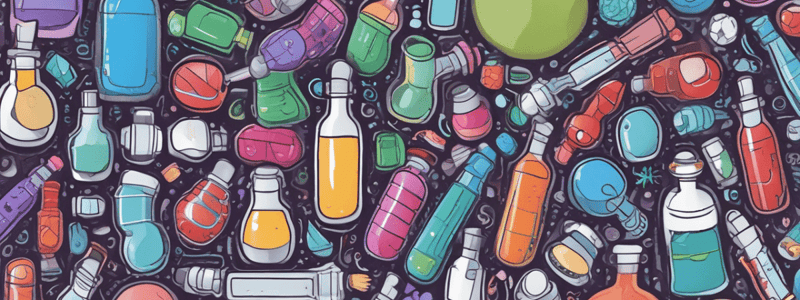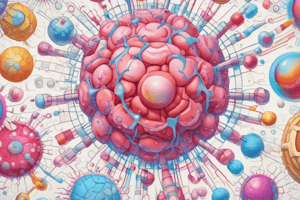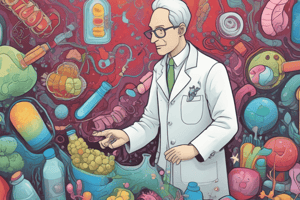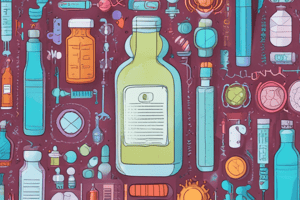Podcast
Questions and Answers
What is the main focus of the b-lactam antibiotics in relation to antibacterial action?
What is the main focus of the b-lactam antibiotics in relation to antibacterial action?
- Preventing DNA replication
- Inhibiting cell wall synthesis (correct)
- Interacting with the plasma membrane
- Inhibiting cell metabolism
Which type of bacteria has a thick cell wall surrounding the plasma membrane?
Which type of bacteria has a thick cell wall surrounding the plasma membrane?
- Antibiotic-resistant bacteria
- Gram-negative bacteria
- Anaerobic bacteria
- Gram-positive bacteria (correct)
What is the primary target of sulphonamides in terms of bacterial cells?
What is the primary target of sulphonamides in terms of bacterial cells?
- Inhibition of cell metabolism (correct)
- Inhibition of DNA replication
- Inhibition of protein synthesis
- Inhibition of cell membrane formation
Which class of antibiotics is known for their acid sensitivity and broadening activity spectrum?
Which class of antibiotics is known for their acid sensitivity and broadening activity spectrum?
In addition to penicillins, which other type of antibiotic is involved in the inhibition of cell wall synthesis?
In addition to penicillins, which other type of antibiotic is involved in the inhibition of cell wall synthesis?
What distinguishes Gram-negative bacteria from Gram-positive bacteria based on their cell walls?
What distinguishes Gram-negative bacteria from Gram-positive bacteria based on their cell walls?
Which strategy is used to improve the stability and absorption of penicillins?
Which strategy is used to improve the stability and absorption of penicillins?
What is the role of 'R' substituents in isoxazoyl penicillins?
What is the role of 'R' substituents in isoxazoyl penicillins?
Which group on the side chain of penicillins improves Gram-negative activity?
Which group on the side chain of penicillins improves Gram-negative activity?
Which penicillin class is considered active only on Gram-negative bacteria?
Which penicillin class is considered active only on Gram-negative bacteria?
What is the result of adding EWGs to penicillins?
What is the result of adding EWGs to penicillins?
What is the effect of adding hydrophilic groups on the acyl side chain of penicillins?
What is the effect of adding hydrophilic groups on the acyl side chain of penicillins?
Why is 6-methylpenicillin INACTIVE?
Why is 6-methylpenicillin INACTIVE?
Which enzyme is the most important for bacteria to gain resistance to penicillin?
Which enzyme is the most important for bacteria to gain resistance to penicillin?
Which protein provides a transport route for penicillin in some Gram-negative bacteria?
Which protein provides a transport route for penicillin in some Gram-negative bacteria?
What is the main reason some Gram-negative bacteria are resistant to penicillin?
What is the main reason some Gram-negative bacteria are resistant to penicillin?
Why do some Gram-positive bacteria release b-lactamase into the surrounding environment?
Why do some Gram-positive bacteria release b-lactamase into the surrounding environment?
What is the role of efflux mechanisms in penicillin resistance in Gram-negative bacteria?
What is the role of efflux mechanisms in penicillin resistance in Gram-negative bacteria?
Which bacterial strain now releases an enzyme that hydrolyses penicillin G in 95% of its strains?
Which bacterial strain now releases an enzyme that hydrolyses penicillin G in 95% of its strains?
What is the most common mechanism for bacteria to gain resistance to penicillin?
What is the most common mechanism for bacteria to gain resistance to penicillin?
What differentiates some Gram-positive and Gram-negative bacteria in terms of b-lactamases?
What differentiates some Gram-positive and Gram-negative bacteria in terms of b-lactamases?
Why do some strains of S. aureus, enterococci, and pneumococci become resistant to penicillin?
Why do some strains of S. aureus, enterococci, and pneumococci become resistant to penicillin?
What is the primary mechanism of action of sulphonamides in inhibiting bacterial growth?
What is the primary mechanism of action of sulphonamides in inhibiting bacterial growth?
Which enzyme is inhibited by trimethoprim in the biosynthetic pathway of tetrahydrofolate?
Which enzyme is inhibited by trimethoprim in the biosynthetic pathway of tetrahydrofolate?
In the discovery of penicillin, what type of mold was found growing on the culture tray?
In the discovery of penicillin, what type of mold was found growing on the culture tray?
Which penicillin analogue has a benzylpenicillin acyl chain?
Which penicillin analogue has a benzylpenicillin acyl chain?
What is the primary mechanism of action of quinolones in inhibiting bacterial growth?
What is the primary mechanism of action of quinolones in inhibiting bacterial growth?
Which antibacterial agent was the first synthetic compound active against a wide range of infections?
Which antibacterial agent was the first synthetic compound active against a wide range of infections?
What is the name of the enzyme inhibited by sulphonamides in the folic acid biosynthesis pathway?
What is the name of the enzyme inhibited by sulphonamides in the folic acid biosynthesis pathway?
Which carboxylic acid was added to the fermentation medium to produce penicillin V?
Which carboxylic acid was added to the fermentation medium to produce penicillin V?
Which antibacterial agent was discovered to have antibacterial properties only in vivo?
Which antibacterial agent was discovered to have antibacterial properties only in vivo?
Which of the following antibacterial agents primarily targets Gram-positive organisms?
Which of the following antibacterial agents primarily targets Gram-positive organisms?
Flashcards are hidden until you start studying
Study Notes
Antibacterial Agents
- Antibacterial agents can be classified into several categories, including:
- Inhibitors of cell metabolism (e.g. sulphonamides)
- Inhibitors of cell wall synthesis (e.g. penicillins, cephalosporins, b-lactamase inhibitors, glycopeptides)
- Inhibitors of nucleic acid transcription and replication (e.g. quinolones, aminoacridines)
- Inhibitors of protein synthesis (e.g. aminoglycosides, macrolides, tetracyclines)
Sulphonamides
- Sulphonamides are a type of antimetabolite that inhibits cell metabolism
- The first synthetic antibacterial agent, prontosil, was discovered to have antibacterial properties in vivo
- Sulphanilamide was the first synthetic antibacterial agent active against a wide range of infections
- Sulphonamides are effective against Gram-positive organisms, but not against Salmonella, and can produce toxic metabolites
- The para-amino group is essential for activity and must be unsubstituted (except when R1 = acyl)
- Aromatic ring and sulphonamide group are both required, and must be directly attached to the aromatic ring
- The sulphonamide and amino groups must be directly attached to the aromatic ring, and the aromatic ring must be para-substituted only
- R2 is the only possible site for variation
- Reducing toxicity is a concern, as sulphonamides can be fatal if they block kidney tubules
- Population differences in metabolism can affect the efficacy of sulphonamides
- Increasing the solubility of sulphonamides can improve their effectiveness
Applications of Sulphonamides
- Sulphonamides are used to treat urinary tract infections, eye infections, mucous membrane infections, and gut infections
- They are particularly useful in treating gut infections
Mechanism of Action of Sulphonamides
- Sulphonamides work by inhibiting the enzyme responsible for the synthesis of folic acid, which is necessary for bacterial growth
- Trimethoprim acts against dihydrofolate reductase, inhibiting DNA synthesis and cell growth
- Cotrimoxazole, a combination of sulphamethoxazole and trimethoprim, inhibits two enzymes in the same biosynthetic pathway, known as "sequential blocking"
Penicillins
- Penicillins are a type of antibacterial agent that inhibits cell wall synthesis
- The discovery of penicillin is attributed to Alexander Fleming, who discovered the mold Penicillium notatum in 1928
- Penicillins were first isolated and purified in 1941, and the structure of penicillin was established using X-ray crystallography in 1945
- The first semi-synthetic penicillin was synthesized in 1957
- Penicillins can be synthesized by fermentation or semi-synthetic procedures
- The mechanism of action of penicillins involves the inhibition of the transpeptidase enzyme, which is responsible for the cross-linking reaction in bacterial cell wall synthesis
- The transpeptidase enzyme is a penicillin-binding protein (PBP)
- Penicillins work by binding to the PBP, inhibiting the cross-linking reaction and preventing bacterial cell wall synthesis
Resistance to Penicillins
- Bacterial resistance to penicillins can occur through several mechanisms, including:
- Physical barriers, such as the presence of a cell wall or outer membrane
- The production of b-lactamase enzymes, which can break down penicillins
- Mutations and genetic transfers that affect the affinity of the transpeptidase enzyme for penicillins
- The presence of porins, which can affect the transport of penicillins into the bacterial cell
- The production of b-lactamase enzymes is a major mechanism of resistance to penicillins
- There are over 1,000 types of b-lactamase enzymes, with different selectivity for penicillins and cephalosporins
- The concentration and affinity of the transpeptidase enzyme can also affect the susceptibility of bacteria to penicillins
Structure-Activity Relationships (SAR) of Penicillins
- The structure of penicillins is critical to their activity, with the b-lactam ring and acyl side chain being essential components
- The acid sensitivity of penicillins can be improved by reducing the neighbouring group participation
- The addition of hydrophobic groups to the side chain can improve the activity of penicillins against Gram-negative bacteria
- The addition of hydrophilic groups to the side chain can improve the activity of penicillins against Gram-positive bacteria
- The use of steric shields can protect penicillins from b-lactamase enzymes
Broader Spectrum of Penicillins
- The spectrum of activity of penicillins can be broadened by modifying the structure of the side chain
- The use of hydrophobic groups on the side chain can improve the activity of penicillins against Gram-negative bacteria
- The use of hydrophilic groups on the side chain can improve the activity of penicillins against Gram-positive bacteria
- The use of aminopenicillins, carboxypenicillins, and ureidopenicillins can improve the activity of penicillins against Gram-negative bacteria
- The use of synergistic combinations of penicillins with other antibacterial agents can improve their effectiveness
Studying That Suits You
Use AI to generate personalized quizzes and flashcards to suit your learning preferences.




